2019 Assessment of the Reserve Bank Information and Transfer System Appendix A: Background Information
- Download the complete Document 1.5MB
This Appendix presents an overview of activity and participation in RITS and the operational performance of RITS over the assessment period, and describes the operational arrangements and key design features of RITS. Material changes to RITS since the previous Assessment are discussed in section 3 of this report.
While the RITS Regulations govern both the core RITS service and FSS, the FSS operates as a separate service from the core RITS service.[20] Except where otherwise noted, this Appendix provides background information on the core RITS service.
A.1 Activity and Participation
Approximately 80 per cent of the value of non-cash payments in Australia is settled in the core RITS settlement system on an RTGS basis (Table A.1). RITS is used to settle time-critical wholesale payments for other financial market infrastructures (FMIs): Australian dollar pay-ins to or pay-outs from CLS Bank International (CLS); margin payments to CCPs; and debt and equity settlement obligations arising in securities settlement systems. RITS also settles the interbank obligations arising from non-cash retail payments.
In the 12 months to March 2019, RITS settled approximately $190 billion in wholesale RTGS transactions on average each day, which is around 6 per cent higher than in the previous twelve months (Graph A.1). The number of transactions also increased over the same period; in the 12 months to March, the average number of wholesale RTGS transactions settled each day increased by around 4 per cent to around 49,000. The peak number of transactions settled on a single day during the assessment period was around 94,000 transactions, while the peak daily value was around $293 billion.
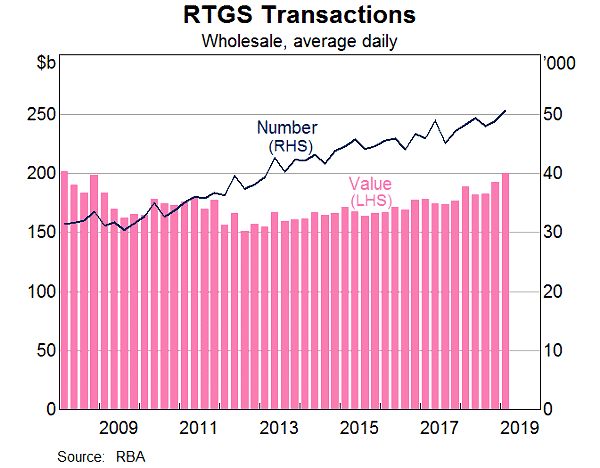
|
Number(b)
'000s |
Value(b)
$ billion |
Interbank settlement
value in RITS $ billion |
|
|---|---|---|---|
| RITS Wholesale RTGS | 49.2 | 189.7 | 184.3 |
| – SWIFT payments (HVCS) | 45.3 | 114.1 | 114.0 |
| – Debt securities (Austraclear)(c) | 3.7 | 62.9 | 57.6 |
| – RITS cash transfers | 0.2 | 12.7 | 12.7 |
| CLS | 69.8 | 311.6 | 2.7 |
| Retail payments | 51,035.7 | 45.2 | 5.0 |
| – Direct entry(d) | 12,761.3 | 39.7 | − |
| – Cheques | 254.5 | 2.9 | − |
| – Credit/charge cards | 11,466.0 | 1.3 | − |
| – Debit cards | 26,553.9 | 1.3 | − |
| Equity settlements (CHESS) | 1,296.7 | 5.2(e) | 0.6 |
| Property settlements (PEXA)(f) | 1.8 | 1.5 | 0.7 |
| NPP | 450.6 | 0.4 | 0.2(g) |
(a) Business days (NPP payments made over seven days but expressed as an average per business day
for comparability) Sources: ASX; CLS; RBA |
|||
In addition to settling individual wholesale payments, RITS also facilitates the settlement of net interbank obligations arising from the equity market (through CHESS, the equities settlement system operated by ASX Settlement), retail payment systems and the property settlement system (see section A.5 for more information on these systems). Equities, property settlement payments and retail transactions are settled as batch payments. The majority of the value of retail payments settled in RITS is from the direct entry system. Transactions originating from NPP are settled in FSS. This service was publicly launched in February 2018, with average daily settlement values increasing steadily over the year.
RITS commenced settling property transactions in late 2014 for the national electronic conveyancing system conducted by PEXA. PEXA can submit linked property transactions for settlement as individual multilateral net batches within RITS.[21]
While they remain a small proportion of overall activity within RITS, the number and value of property batches settling in RITS has continued to grow rapidly over the year (Graph A.2).
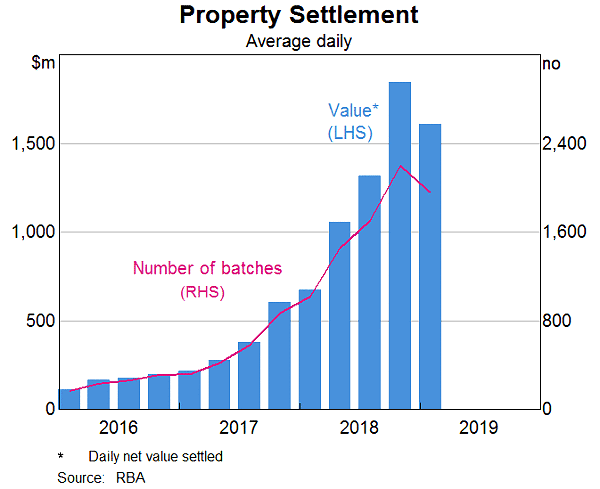
Agency arrangements for wholesale RTGS payments
Under the Bank's ESA policy, ADIs that account for 0.25 per cent or more of the total value of wholesale RTGS transactions, and systemically important CCPs, are required to settle their AUD obligations in RITS using their own ESAs (see section A.9 for further details on access and participation in RITS). An ADI with a share of transactions of less than 0.25 per cent of the total value of wholesale RTGS transactions is permitted to use an agent to settle its transactions. ADIs that elect to use an agent to settle their transactions have the option of holding a dormant ESA for contingency purposes.
As at the end of March, 41 ADIs held dormant ESAs (Table A.2). The value of wholesale RTGS payments settled by these members has remained very low, at below 1 per cent of total RTGS payments over the assessment period. Activity in RITS remained highly concentrated among the major domestic banks and foreign banks, both in terms of number and value of RTGS payments.
|
Number of ESAs
As at end March 2019 |
Number of payments(b)
Per cent of total, year to end March 2019 |
Value(b)
Per cent of total, year to end March 2019 |
|
|---|---|---|---|
| Major domestic banks | 4 | 62.20 | 50.27 |
| Foreign institutions | 35 | 32.13 | 40.43 |
| Other domestic institutions | 16 | 2.84 | 2.41 |
| Clearing and settlement facilities and the Bank | 5 | 2.83 | 6.88 |
| Dormant accounts(c) | 41 | − | − |
| Total | 101 | 100.0 | 100.0 |
|
(a) Excludes RITS members that do not hold an ESA Source: RBA |
|||
Since RITS is an RTGS system, members need access to additional liquidity (relative to a deferred-net settlement system) in order to settle payments individually. Liquidity can be sourced from members' opening ESA balances and additional funds made available to members by the Bank via its intraday liquidity facility (see section A.7 for details). The aggregate of opening ESA balances is primarily determined by the Bank's open market operations (OMOs) and liquidity provided under open repos. Open repos facilitate the settlement of same-day direct entry payments, as evening settlement obligations arising from the direct entry system are unknown before the close of the interbank cash market. Open repos also provide liquidity for FSS settlements of NPP payments initiated after 4.45 pm Australian Eastern Standard Time (AEST)/Australian Eastern Daylight-saving Time (AEDT) on business days, as well as on weekends and public holidays. Average liquidity in RITS increased sharply following the introduction of open repos (Graph A.3, top panel).
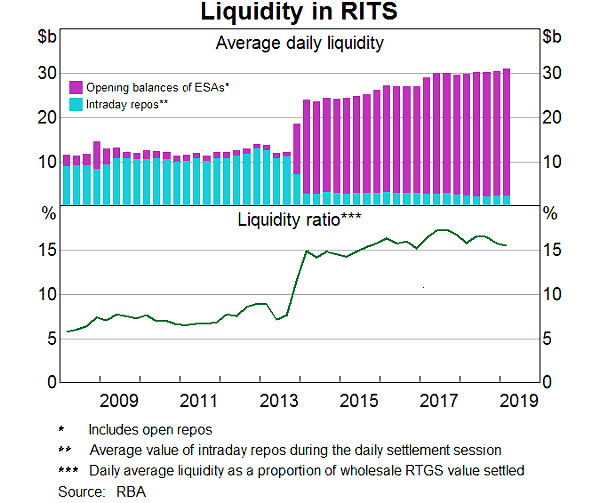
System liquidity plays a role in the timely settlement of RTGS transactions. In general, settling payments earlier in the day is desirable as it limits the potential adverse consequences if a participant or RITS were to experience an operational issue late in the day. The ratio of system liquidity to the value of payments settled had been slowly increasing from around 2007, and then doubled following the introduction of open repos (Graph A.3, bottom panel). The liquidity buffer created by open repos results in higher levels of system liquidity being available earlier in the day and therefore has contributed to the earlier settlement of payments in RITS. The average time of day when half of payments, by value, have settled has moved progressively earlier; from between 2.00 pm and 3.00 pm in the mid 2000s, to between around 12.00 pm and 1.00 pm in recent years (Graph A.4).
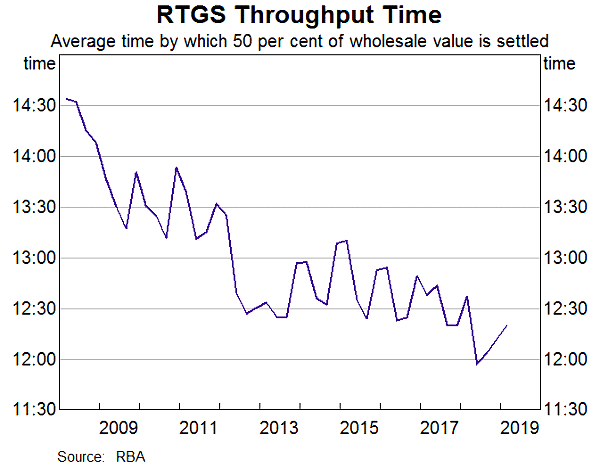
A.2 Operational Risk
RITS availability
A key operational target is for RITS to be available to its members in excess of 99.95 per cent of the time. Availability is measured relative to the total number of hours that the system is normally open for settlement (see section A.6). During the assessment period, the Bank conducted a review of its methodology for measuring RITS availability. Under the revised methodology, the Bank calculates the availability of RITS as the simple average of availabilities calculated for each of five component services of RITS (Table A.3).
On 30 August, the Bank experienced a major power outage at a production site that resulted in large-scale within-day disruption to its IT systems, including systems providing settlement and payments processing services (see section 3.1.1). This resulted in RITS recording overall availability below its target level of 99.95 per cent. More recently, on 7 February, another incident caused by the inadvertent shutdown of the RITS production system during maintenance work on test systems resulted in disruption to settlement processing for around one and a half hours.
| RITS availability(a) | |
|---|---|
| 2018 | 99.83 |
| 2017 | 99.98 |
| 2016 | 99.99 |
| 2015 | 99.83 |
Note: Availability in 2018 represents the average of the five component service
availabilities.
|
|
|
(a) The methodology for calculating RITS availability changed in 2018. Availability for 2017 and
earlier years relates to Bank-operated systems. Source: RBA |
|
In addition to its availability target, RITS also has capacity targets. These include a:
- processing throughput target, which aims to ensure that RITS is able to process the peak-day transactions in less than two hours (assuming no liquidity constraints)
- projected capacity target, which specifies that RITS should be able to accommodate projected volumes 18 months in advance with 20 per cent headroom.
RITS is regularly tested against these targets and continues to meet them.
External dependencies
The Bank maintains service level agreements with SWIFT, Austraclear, and other feeder systems that set out availability targets, as well as expected response times and level of support should an issue arise. RITS also has critical dependencies on utility providers. To manage these dependencies, both the main and backup sites have an uninterruptable power supply and a backup power generator system. All external communications links to data centres are via dual, geographically separated, links.
The efficient operation of RITS is also dependent on the operational reliability and resilience of its members. An operational disruption at a member could prevent it from sending payment instructions to RITS. This could in turn cause liquidity to accumulate in that member's ESA, forming what is known as a ‘liquidity sink’, and preventing liquidity from being recycled through the system efficiently. Recognising this interdependency, the Bank published Business Continuity Standards for direct participants in RITS in May 2013. These standards aim to promote high availability in RITS payments processing operations, requiring both resilience of system components and rapid recovery if failover to alternative systems is required.[22] The Business Continuity Standards were revised in 2018 to strengthen the operational resilience of RITS members, particularly against cyber threats, with a target for members to fully comply with the revised standards by the February 2020 annual attestation.
The Bank monitors compliance with the Business Continuity Standards on an ongoing basis. Each member that directly participates in RITS is required to submit an annual self-certification statement against the standards. As at the end of 2018, 50 of 62 RITS direct participants self-certified that they were fully compliant with the standards. For some members, the reported non-compliance related to the revised standards discussed above, for which full compliance is targeted by the February 2020 self-certification. Where non-compliance relates to other standards previously in place, the Bank has asked members to provide an expected date for compliance and will follow up progress with members.
Since both the FSS and the core RITS service settle payments using funds in member ESAs, it is possible that an operational disruption in the FSS could affect the funds available to members to settle core RITS payments. This risk is mitigated by the use of separate balances within each member's ESA that can be used only to settle payments in the related settlement queue and by applying resilience standards in FSS that are at least equivalent to those in the core RITS service.[23]
A.3 Governance and Oversight
RITS is owned and operated by the Bank. Since it is not operated as a separate legal entity, the management and operation of RITS fall under the governance structure of the Bank and are therefore subject to its normal oversight, decision-making and audit processes. The Bank publishes specific objectives in relation to its operation of RITS on its website.[24] These are consistent with the high-level objectives of the Bank, which emphasise the stability of the broader financial system and the welfare of the Australian people. The Bank accordingly aims to provide infrastructure through which settlement obligations arising from the exchange of high-value payments and debt securities settlements can be completed in a safe and efficient manner.
The governance structure as it applies to RITS is shown in Figure A.5. In accordance with the Reserve Bank Act 1959, the Governor is responsible for the management of the Bank, and is therefore ultimately responsible for the operation of RITS. The Governor is assisted and supported in this responsibility by the Executive Committee, which comprises senior executives. Day-to-day operations, liaison with members, and the ongoing development of RITS are delegated to the Bank's Payments Settlements Department.
RITS is also subject to oversight by the Bank's Payments Policy Department, within the policy framework for which the Payments System Board has ultimate responsibility.[25] The Executive Committee has established an internal FMI Review Committee to govern oversight activities within this framework. This committee is chaired by the Assistant Governor (Financial System) and includes at least a further five senior members of Bank staff with relevant experience.
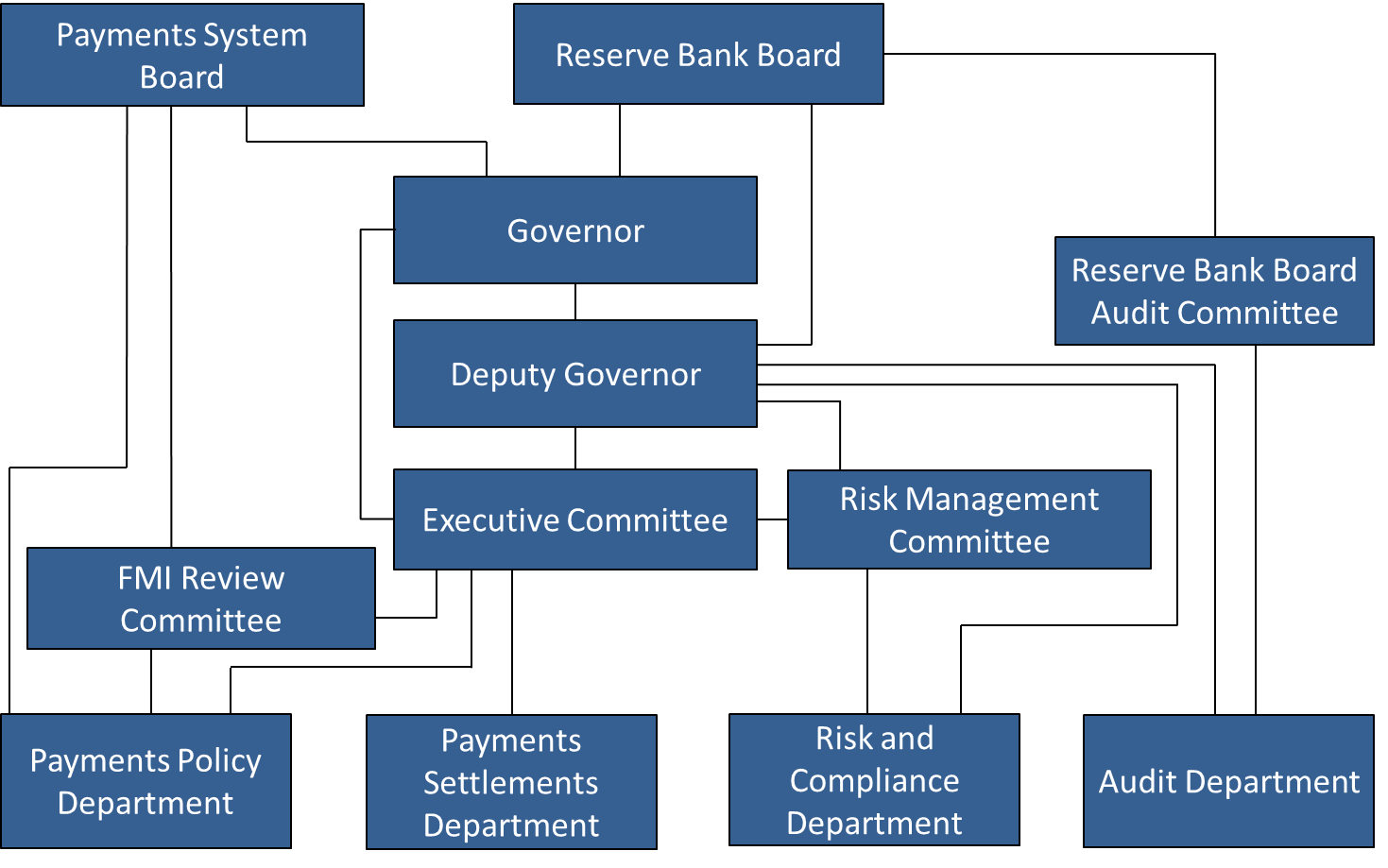
Source: RBA
A.4 Design Features
ESA funds are allocated between the core RITS service and FSS. The RITS balance is used for funding high-value payments and multilaterally netted settlements. The FSS balance is used for funding the real-time settlement of consumer and business NPP payments. Members can control the use of liquidity within the system by setting parameters to automatically allocate ESA funds to or from FSS. For example, there is functionality allowing members to set criteria (upper, lower and reset point values) that are used by RITS to automatically generate allocation transfers between members' FSS and RITS balances (Figure A.6).
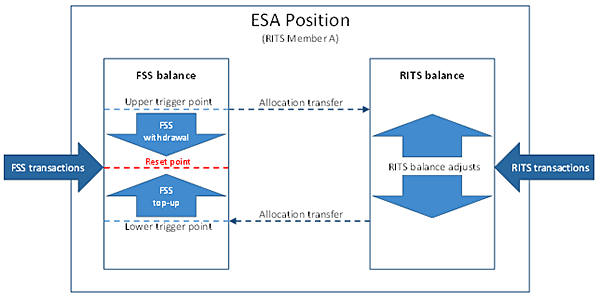
The core RITS system is designed to enhance efficiency in the use of liquidity within the system. Wholesale transactions in RITS are settled on a central queue. The RITS central queue uses a ‘next-down looping’ algorithm to continuously retest unsettled payments in order of submission (Figure A.7). If the transaction being tested for settlement cannot be settled individually using the RITS balance, the auto-offset algorithm searches for up to 10 offsetting transactions (based on the order of submission) between the pair of members and attempts to settle these simultaneously.[26] Members can also nominate specific offsetting payments to be settled simultaneously to assist in managing client credit constraints; this functionality is known as ‘targeted bilateral offset’.
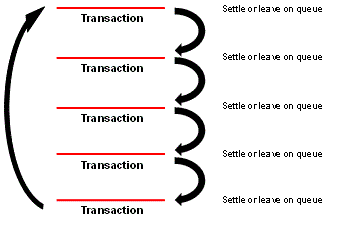
Source: RBA
Members have access to a range of real-time information in RITS to enable them to manage their liquidity efficiently and effectively. In particular, members have access to information on their current ESA balances, settled payments and receipts, queued inward and outward transactions, the value of first- and second-leg intraday repos, their projected end-of-day ESA balances, and their FSS balance and RITS/FSS allocation transfer facilities.
RITS also has features that allow members to efficiently manage and conserve liquidity. Members can use ‘sub-limits’, which they can change at any time during the settlement day, to reserve liquidity for priority payments. There are three payment statuses available to members, which determine how wholesale RITS individual transactions draw on liquidity:
- Priority payments are tested against the full RITS balance less funds reserved for property settlement.
- Active payment instructions are settled if the paying institution has sufficient funds in its RITS Balance above the sum of the member's specified sub-limit and any property settlement reservations.
- Payments with a deferred status are not tested for settlement until their status is amended.
This functionality can be accessed through either the RITS user interface or via SWIFT messages. Members can change the status of each payment individually, or they can choose to automatically set the status of all payments of a particular type, above and below a member set threshold.[27]
A.5 Systems Linked to RITS
Wholesale RTGS payment instructions can be submitted to RITS directly as RITS cash transfers, or through two feeder systems: SWIFT Payment Delivery System (PDS) and Austraclear. The SWIFT PDS is a closed user group administered by the Australian Payments Network, which sets rules and procedures for clearing payments in Australia through its High Value Clearing System (HVCS). The SWIFT PDS is used primarily to make customer and interbank payments, with interbank settlement occurring across ESAs in RITS. Austraclear transactions submitted to RITS for settlement generally represent the cash legs of debt security transactions, which are settled on a delivery-versus-payment model 1 basis.[28] Payment instructions that are not associated with the settlement of securities transactions may also be sent for settlement via the Austraclear system. Other FMIs with ESAs (i.e. CLS, the ASX CCPs and LCH) use these feeder systems to settle AUD obligations arising from the systems they operate.
RITS also facilitates the multilateral net settlement of interbank obligations arising from other systems (Table A.4). The settlement of obligations arising in the retail payment systems administered by the Australian Payments Network is facilitated by the Bank's LVSS in RITS.[29] All other multilateral net batches are administered by ‘batch administrators’ and entered into RITS through its batch feeder functionality.[30]
| Linked system | Underlying transaction types | Governance and ownership |
|---|---|---|
| CHESS Batch | Primarily equity security transactions | The CHESS Batch is administered by ASX Settlement, which is owned by ASX Group. ASX Settlement is licensed as a clearing and settlement facility and is subject to the Bank's Financial Stability Standards for Securities Settlement Facilities. |
| Low Value Settlement Service | Cheque, Direct Entry (including the BPAY system), Visa and ATM transactions | Each retail payment system has its own rules and procedures. These rules and procedures are determined by the system administrator (e.g. the Australian Payments Network), in consultation with its members. |
| MasterCard Batch | MasterCard brand credit and debit card payments | MasterCard is a privately owned company incorporated in the US and listed on the New York Stock Exchange. |
| PEXA Batches | Property transactions | PEXA is owned by a consortium consisting of Commonwealth Bank of Australia, Link Market Services and Morgan Stanley Infrastructure. |
| eftpos Batch | eftpos brand debit card payments | The eftpos Batch is administered by the member-owned eftpos Payments Australia Limited. |
A.6 Operating Hours
Standard settlement hours in the core RITS service, as established by the RITS Regulations, are 7.30 am to 10.00 pm.[31] Settlement of SWIFT and Austraclear transactions cease at 6.30 pm AEST and 8.30 pm during AEDT (the first Sunday in October to the first Sunday in April).
Prior to 9.15 am, settlement in RITS is limited to the deferred net obligations settled in the 9.00 am settlement process (during the 9.00 am processing session) (Figure A.8), and, before the 9.00 am settlement process, settlement of RITS cash transfers, interbank Austraclear transactions, obligations for the MasterCard and eftpos batches and direct entry government clearings. Other payment instructions can be submitted to RITS during this time, but they are not tested for settlement until the daily settlement session commences at 9.15 am.
| RITS Session | Time window | Transactions able to be settled |
|---|---|---|
| Morning settlement session | 7.30 am - 8.45 am | Eftpos,batch transactions Mastercard batch transactions Cash transfers Low value settlement service |
| 9.00 am processing session | 8.45 am - 9.15 am | Low value settlement service Cash transfers |
| Daily settlement session | 9.15 am - 4.30 pm | All services(a) |
| Settlement close session | 4.30 pm - 5.15 pm | Settlement of queued transactions |
| Evening settlement session | 5.15 pm - 10.00 pm | Cash transfers Low value settlement service SWIFT(b) Property settlement batches(b) Austraclear(b) |
|
(a) Includes all batch transactions, LVSS, SWIFT, Austraclear and cash transfers. Source: RBA |
||
There are also restrictions on the types of payments that can settle in the RITS evening settlement session. Only ‘evening agreed’ settlement participants, as defined in the RITS Regulations, can participate fully in the evening settlement session from 5.15 pm onwards.[32] Consequently, to allow the settlement of remaining queued transactions at the end of the day session there is a 45-minute settlement close session. At the end of the settlement close session at 5.15 pm, any remaining queued payments that are not flagged as being ‘evening eligible’ are removed from the queue.
A.7 Liquidity Provision
To facilitate the settlement of payments in RITS, the Bank provides liquidity to members at low cost via its Standing Facilities. Under these facilities, a member can enter into a repo with the Bank; a repo transfers outright title of eligible securities to the Bank (upon purchase of securities) in return for a credit to the member's ESA, with an agreement to reverse the transaction at some point in the future. Standing facilities are available to any RITS member which is ‘approved’ by the Bank's Domestic Markets Department and settles its payments across its own ESA (for more information on eligibility criteria for OMOs and Standing Facilities see section A.9).
There are three types of repos that can be performed under the Bank's Standing Facilities:
- Intraday repos. For these repos, both the sale and repurchase occur on the same day. They are provided free of charge (except for a small settlement transaction fee), but must be reversed before the settlement of Austraclear transactions ceases in RITS.
- Overnight repos. In the exceptional case that a member is unable to reverse an intraday repo by the end of the day, the transaction may, with the approval of the Bank, be converted to an overnight repo. Interest would then be charged at 25 basis points above the cash rate target.
- Open repos. This type of repo does not specify the date on which the transaction will be reversed. The member retains the liquidity for use on future days. Open repos help members meet their settlement obligations without having to actively manage their liquidity, particularly outside of normal banking hours. Open repos were introduced to facilitate the settlement of evening direct entry payment obligations, the size of which are unknown prior to the close of the interbank cash market and Austraclear. They also support the settlement of NPP obligations arising in FSS. For members that settle direct entry or NPP obligations across their own ESA, the Bank determines a minimum position in open repos that the member should maintain.[33] To the extent that these members retain matching funds against their open repo position (subject to an allowance for variations in ESA balances arising from settlement of direct entry and NPP obligations that occur outside of normal banking hours), those ESA balances are compensated at the cash rate target. However, to preserve the incentive for RITS members to remain active in the interbank cash market while it is open, ESA funds surplus to the ESA holder's open repo position (subject to the direct entry allowance) earn a rate 25 basis points below the cash rate target, while any shortfall in funds incurs a 25 basis point charge.
Members can also source liquidity through term repos and some outright transactions conducted in the Bank's OMOs. The overall amount of ESA funds available via these operations is set by the Bank to support the implementation of monetary policy. These transactions usually involve counterparties selling debt securities to the Bank either under repo or outright.
A.8 Credit Risk and Collateral
The Bank is not exposed to any credit risk from the settlement of wholesale payments in RITS, or from the settlement of NPP payments in FSS. Wholesale payments in RITS are settled using funds in members' RITS Allocation and payments settled in FSS use the member's FSS Allocation. Neither of these allocations can be overdrawn, and the Bank does not guarantee any transaction submitted for settlement in RITS or FSS.
The Bank does, however, incur credit risk through the provision of liquidity to members through OMOs and Standing Facilities to support payments and settlement activity (for more information on OMOs and Standing Facilities see section A.7). It manages this credit risk by lending funds via purchase of securities under repo. Consequently, the Bank would only face a loss if a RITS member failed to repurchase securities sold under repo and the market value of the securities fell to less than the agreed repurchase amount. To manage this risk, the Bank purchases under repo only highly rated debt securities denominated in AUD and lodged in Austraclear. All securities purchased under repo are conservatively valued, and subject to haircuts and daily margin maintenance.
To enter into a repo with the Bank, an entity must meet eligibility criteria. Counterparties must be: a RITS member and an Austraclear member (and the legal entity holding the Austraclear account must be identical to the legal entity that is a participant in RITS); subject to ‘appropriate regulation’ (for example, an entity regulated by APRA, or a clearing and settlement facility overseen by the Bank); and able to ensure efficient and timely settlement of transactions within Austraclear. To access the Bank's Standing Facilities, an approved counterparty must also settle its payments across its own ESA.[34]
A.9 Access and Participation
Since settlement in RITS occurs using central bank money, only institutions that hold an ESA with the Bank can be settlement participants in RITS. Furthermore, since RITS is the only means of access to ESAs, all ESA holders must be RITS members and meet its operating conditions. The eligibility criteria to hold an ESA with the Bank therefore effectively represent the eligibility criteria for settlement participants in RITS. Policy on ESA eligibility is set by the Bank's Executive Committee, and is available on the Bank's website.[35] The policy has been designed to be fair and open, and to promote competition in the provision of payment services by allowing access to all providers of third-party payment services, irrespective of their institutional status. ADIs are eligible by default, because these institutions are assumed to provide third-party payment services as part of their business. Australian-licensed CCPs and securities settlement facilities (SSFs) with payment arrangements that require AUD settlement are also eligible to hold an ESA.[36] Only ESA holders which are also full participants or settlement participants as defined in the NPP Regulations are eligible to settle NPP payments in the FSS.
The ESA eligibility policy sets a number of risk-based participation requirements, including around operational capacity and access to liquidity. These are designed to reduce the likelihood that an individual member experiences an operational or financial shock that could disrupt the system more broadly. The application of participation requirements aims to be proportional to a prospective member's expected payments business in RITS. To reduce the operational burden on smaller RITS members, ADIs with aggregate outgoing RTGS transactions of less than 0.25 per cent of the total value of wholesale RTGS transactions may use an agent to settle their RITS transactions, rather than settling directly across their own ESAs. Payments settled on an RTGS basis through the FSS are not included in the calculation of the 0.25 per cent threshold.
The Bank's ESA policy limits the scope for material risks to arise from tiered participation arrangements. Since only ADIs individually accounting for less than 0.25 per cent of the total value of wholesale RTGS transactions may settle through an agent, no individual indirect member would be expected to pose material risk to either its agent or the system more broadly. Further, to reduce dependence on its agent, a member that participates indirectly has the option of maintaining an ESA for contingency purposes (see section 3.3.1). To ensure that RITS has sufficient information about indirect participation, agents acting for ADIs that participate indirectly are required to report the value and volume of their ADI client's outgoing RTGS payments to the Bank on a quarterly basis. This information is used to monitor compliance with the 0.25 per cent threshold.
Footnotes
The Bank does not presently assess these systems against the Principles. The Bank will continue to monitor developments in NPP and FSS, and periodically review whether an assessment against the Principles should be conducted in future. [20]
For more information on property settlement functionality in RITS see section 3.2.3 in RBA (2014), 2014 Assessment of the Reserve Bank Information and Transfer System, p 13. Available at https://www.rba.gov.au/payments-and-infrastructure/rits/self-assessments/2014/. [21]
For more information on the participant Business Continuity Standards, see Box E: Participant Business Continuity Standards in RBA (2013), 2013 Self-assessment of the Reserve Bank Information and Transfer System, p 27 https://www.rba.gov.au/payments-and-infrastructure/rits/self-assessments/2013/. [22]
For more information on the NPP and FSS, see Box B from the 2018 RITS assessment, available at https://www.rba.gov.au/payments-and-infrastructure/rits/self-assessments/2018/pdf/2018-assess-rits.pdf. [23]
Available at https://www.rba.gov.au/payments-and-infrastructure/rits/about.html. [24]
Payments Policy Department and Payments Settlements Department are separate departments in the Bank's organisational structure, with separate reporting lines up to and including the level of Assistant Governor. [25]
Payments will only trigger ‘auto-offset testing’ if they have been on the queue for at least one minute. [26]
For example, a member may wish all small SWIFT transactions to be given an ESA Status of priority to allow them to settle quickly out of the priority tranche of ESA funds; transactions above the member-set threshold could be given a status of active to allow manual liquidity management for these transactions. [27]
That is, the cash leg of the transaction is settled on a gross basis simultaneously with the transfer of the security. [28]
For more information on the LVSS, see Box A: Developments in Retail Payments Settlement Arrangements, in the 2013 Self-Assessment of the Reserve Bank Information and Transfer System. [29]
To ensure that a batch administrator can administer the batch in a safe and efficient manner, the Bank requires that it meets certain risk-based requirements. For more information, see https://www.rba.gov.au/payments-and-infrastructure/rits/information-papers/eligibility-criteria-for-batch-administrator/. [30]
During AEST, the 7.15 pm and 9.15 pm direct entry settlements occur after the close of the interbank cash market. However, during AEDT, Austraclear and SWIFT transactions continue to be settled until 8.30 pm, so only the last direct entry settlement occurs outside normal banking hours. [31]
RITS members do not have to be evening agreed if they only participate in direct entry and property settlements after 5.15 pm. [32]
To limit the need for ESA holders to contract intraday repos on a regular basis, the Bank may agree to contract an amount of open repos (at the cash rate target) over and above the stipulated minimum position. This includes ESA holders that do not participate directly in the settlement of direct entry obligations in RITS. These maximum permitted positions in open repos are reviewed at least annually. [33]
For more information on the Bank's counterparty eligibility criteria, see https://www.rba.gov.au/mkt-operations/resources/tech-notes/eligible-counterparties.html. [34]
The ESA Policy is available at https://www.rba.gov.au/payments-and-infrastructure/esa/. [35]
Under the Bank's Financial Stability Standards for Central Counterparties a CCP that the Bank determines to be systemically important in Australia and has Australian dollar obligations is required to settle its Australian dollar obligations across its own ESA or that of a related body corporate acceptable to the Bank. [36]